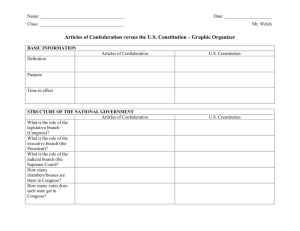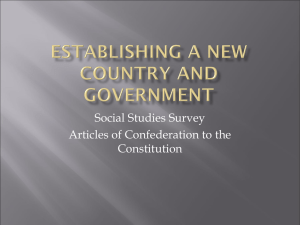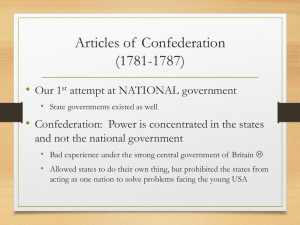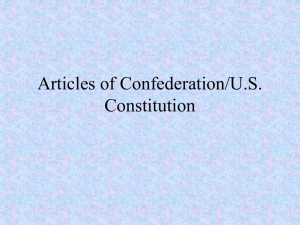Study Guide #4 - Cloudfront.net
advertisement
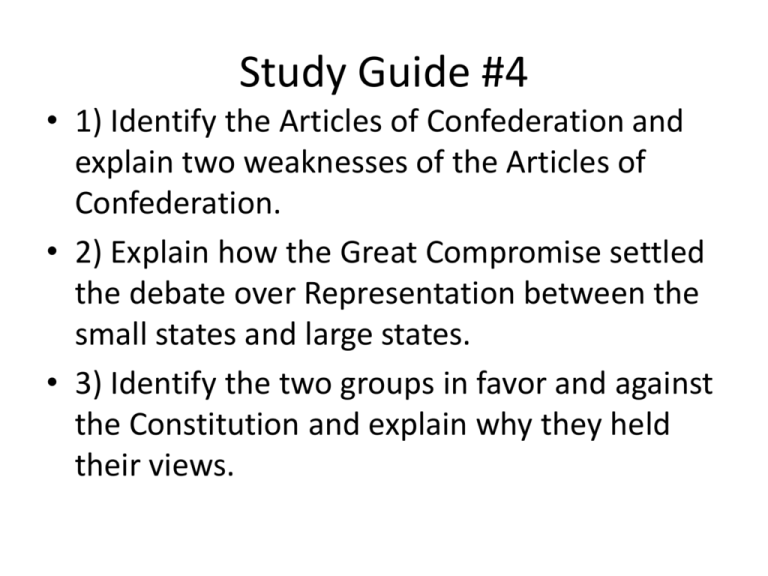
Study Guide #4 • 1) Identify the Articles of Confederation and explain two weaknesses of the Articles of Confederation. • 2) Explain how the Great Compromise settled the debate over Representation between the small states and large states. • 3) Identify the two groups in favor and against the Constitution and explain why they held their views. 1) What were the three concerns over the issue of power regarding a new government • a) Where should power reside – States or Central government • Americans were suspicious of a strong central power. Why – Because we just broke away from an Empire and King that ruled us unfairly from 3000 miles away • b) Bi-cameral or unicameral (Legislature- make laws) – One house might be more efficient but could be manipulated more easily by one group • c) How would representation be apportioned (by population or equal per state) – Would larger states have more power than smaller states, how would smaller states have a say in new government 2) Identify the four weaknesses of the Articles of Confederation (first American government) • A) Unicameral assembly with ONE VOTE PER STATE – What is the problem with one vote per state? • Small states have an inordinate amount of power • b) NO PRESIDENT – Why is a President so important? Why did Americans not want a President? • Represents all Americans and can make quick decisions • Colonies did not want a King • c) Supermajority (9/13 had to approve a new law) • d) Unanimity to amend/change Articles – What is the problem with needing a supermajority to make laws? • Very hard to get a majority and makes laws when needed/ small minority could stop legislation 3) Briefly describe the 2 achievements of the Articles of Confederation • A) Land Ordinance of 1785 – Designed a way to divide land in the west and sell land to new settlers, money raised would be used for education • Why was education seen as so important? (FARMERS) – Educated electorate who could be informed voters • B) Northwest Ordinance – Devised a way that a new territory could become a state • 1) Territory would be run by Congress until… • 2) 5000 settlers- could form a territory and elect representatives to legislature and 1 rep to Congress • 3) 60,000 settlers- apply for statehood (3-5 states in Northwest_ – Ohio, Indiana, Illinois, Michigan, Wisconsin 4) Why was Shay’s Rebellion significant? (What did it prove to the elite of America?) • Proved that America needed a strong central government that could enforce laws – Elite felt that civil disobedience could spread easily (threatening their plantations, homes, and wealth) • Why would people think the poor can rise us and burn stuff? – Natural Rights- purpose of government is protect your property, government needed to be effective in order to fulfill it’s duties 5) What was the difference between the Virginia Plan and New Jersey Plan • A) Virginia Plan (James Madison) becomes the basis of the constitution – Bi-cameral Legislature- two house congress – Executive Branch- President – Representation- based on Population (large state plan) • B) New Jersey Plan – Apportioned Representation- equal representation per state • Why is the issue of representation so sensitive to states? – Because each state was sovereign and giving up their power, they wanted to insure they had power in the new central government 6) Identify two parts of the Great Compromise • Two house Congress (legislature to make laws) – House of Representatives- based on population • Favors large states – Senate- equal representation (2 Senators per state) • Both the Senate, House of Representatives, AND the President have to approve all new laws!!! If one does not like a new law, it goes back and gets reworked or thrown away 7) Who comprises the Legislative Branch? What are it’s powers • Congress (House of Representatives and Senate) makes the laws – $- controls how money is spent – Declares war 8) Who is the head of the executive branch? What are it’s powers? • President – Enforces laws – Veto- congressional bills – Head of the Military 9) What is the main idea of the Federalists and AntiFederalists? • Federalists- supported the Constitution as is (wanted a strong central government) • Anti-Federalists- fearful of a strong central government – Wanted a Bill of Rights to protect them from bad government 10) What was the main idea of Federalist #10 • Large Republics can work with diverse groups – Because one group can not take over when there are lots of different interest • Who controls America today? –NO ONE!!! • 12) Bicameralism – Two house legislature • 13) Separation of Power – 3 branches of government (prevents one part of government from having too much power) • Executive, Legislative, Judicial • 14) Federalism – Power is divided between the States and Federal/Central Government • 15) What does the 10th Amendment confirm? – Anything not in the constitution is given to the states to decide (States rights amendment)




